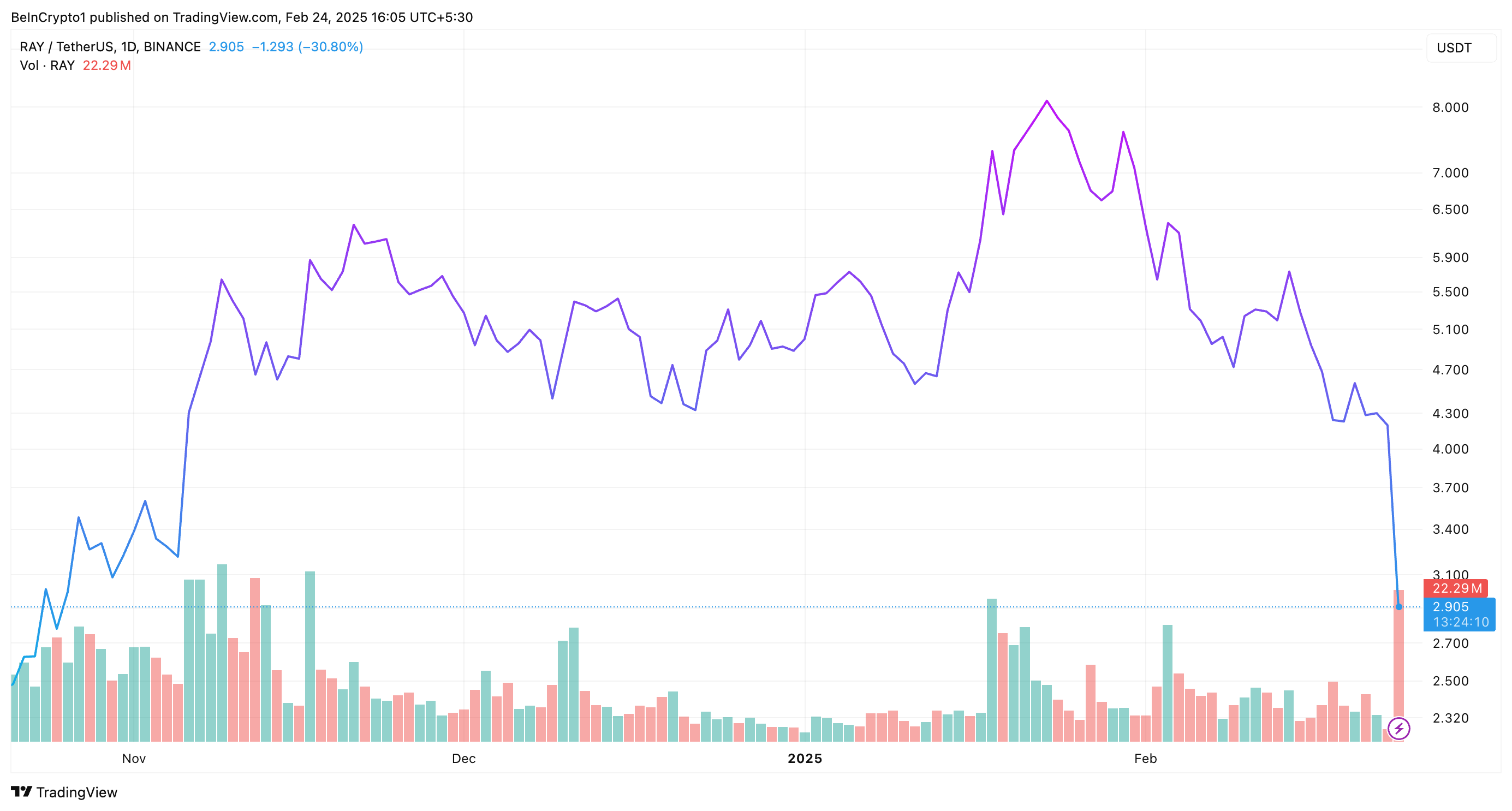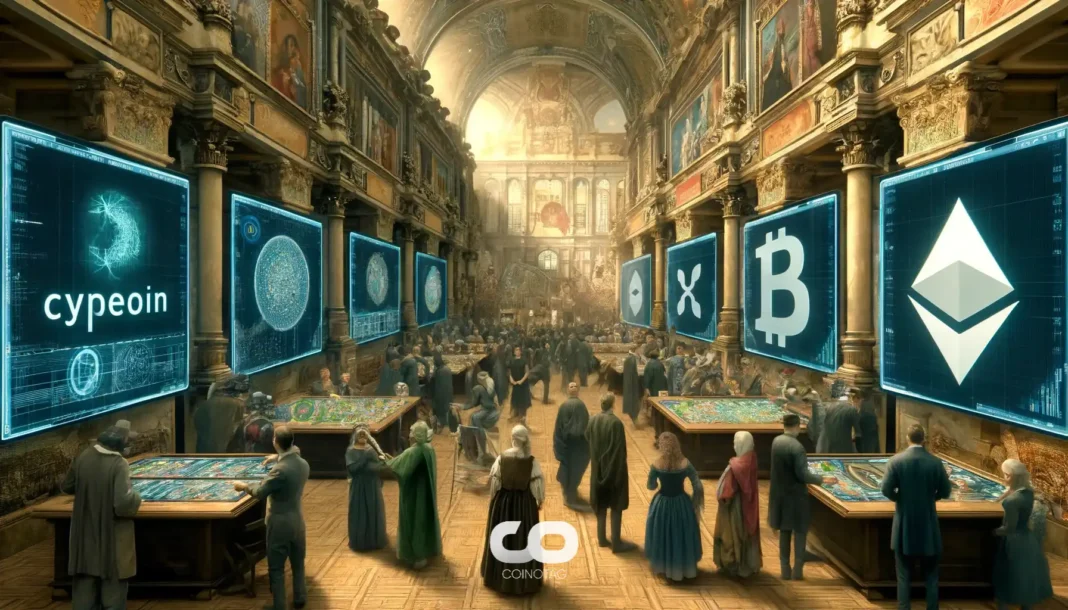| COINOTAG recommends • Exchange signup |
| 💹 Trade with pro tools |
| Fast execution, robust charts, clean risk controls. |
| 👉 Open account → |
| COINOTAG recommends • Exchange signup |
| 🚀 Smooth orders, clear control |
| Advanced order types and market depth in one view. |
| 👉 Create account → |
| COINOTAG recommends • Exchange signup |
| 📈 Clarity in volatile markets |
| Plan entries & exits, manage positions with discipline. |
| 👉 Sign up → |
| COINOTAG recommends • Exchange signup |
| ⚡ Speed, depth, reliability |
| Execute confidently when timing matters. |
| 👉 Open account → |
| COINOTAG recommends • Exchange signup |
| 🧭 A focused workflow for traders |
| Alerts, watchlists, and a repeatable process. |
| 👉 Get started → |
| COINOTAG recommends • Exchange signup |
| ✅ Data‑driven decisions |
| Focus on process—not noise. |
| 👉 Sign up → |
-
Raydium’s native token, RAY, suffered a significant setback, dropping 31% as rumors swirl around Pump.fun’s new Automated Market Maker (AMM).
-
The implications of this development may reshape the liquidity dynamics within the Solana blockchain, jeopardizing Raydium’s historical position.
-
“Pump.fun is working on their own AMM liquidity pools, which is currently being tested on amm.pump.fun,” noted a prominent blockchain analyst.
Raydium’s RAY token plummets 31% as speculation of a competing AMM from Pump.fun arises, posing a potential threat to Raydium’s market position.
Pump.fun’s AMM Testing Sparks Raydium (RAY) Sell-Off
Over the past day, RAY has seen a 31% drop in value. At the time of writing, the token traded at $2.9. This marked its lowest price since late October 2024.

The decline appears to have been triggered by the discovery of a test version of an AMM under the URL “amm.pump.fun.” An on-chain sleuth, “trenchdiver,” spotted this, and it quickly gained traction across the social media platform X (formerly Twitter).
| COINOTAG recommends • Professional traders group |
| 💎 Join a professional trading community |
| Work with senior traders, research‑backed setups, and risk‑first frameworks. |
| 👉 Join the group → |
| COINOTAG recommends • Professional traders group |
| 📊 Transparent performance, real process |
| Spot strategies with documented months of triple‑digit runs during strong trends; futures plans use defined R:R and sizing. |
| 👉 Get access → |
| COINOTAG recommends • Professional traders group |
| 🧭 Research → Plan → Execute |
| Daily levels, watchlists, and post‑trade reviews to build consistency. |
| 👉 Join now → |
| COINOTAG recommends • Professional traders group |
| 🛡️ Risk comes first |
| Sizing methods, invalidation rules, and R‑multiples baked into every plan. |
| 👉 Start today → |
| COINOTAG recommends • Professional traders group |
| 🧠 Learn the “why” behind each trade |
| Live breakdowns, playbooks, and framework‑first education. |
| 👉 Join the group → |
| COINOTAG recommends • Professional traders group |
| 🚀 Insider • APEX • INNER CIRCLE |
| Choose the depth you need—tools, coaching, and member rooms. |
| 👉 Explore tiers → |
“Pump.fun is working on their own AMM liquidity pools, which is currently being tested on amm.pump.fun,” the user posted.
The implications of this move are significant. Raydium is a leading AMM and liquidity provider on the Solana blockchain. It has long benefited from its symbiotic relationship with Pump.fun.
| COINOTAG recommends • Exchange signup |
| 📈 Clear interface, precise orders |
| Sharp entries & exits with actionable alerts. |
| 👉 Create free account → |
| COINOTAG recommends • Exchange signup |
| 🧠 Smarter tools. Better decisions. |
| Depth analytics and risk features in one view. |
| 👉 Sign up → |
| COINOTAG recommends • Exchange signup |
| 🎯 Take control of entries & exits |
| Set alerts, define stops, execute consistently. |
| 👉 Open account → |
| COINOTAG recommends • Exchange signup |
| 🛠️ From idea to execution |
| Turn setups into plans with practical order types. |
| 👉 Join now → |
| COINOTAG recommends • Exchange signup |
| 📋 Trade your plan |
| Watchlists and routing that support focus. |
| 👉 Get started → |
| COINOTAG recommends • Exchange signup |
| 📊 Precision without the noise |
| Data‑first workflows for active traders. |
| 👉 Sign up → |
The launchpad allows users to create and launch meme coins at a low cost, while Raydium provides liquidity infrastructure. Once these tokens gain traction, they enter Raydium’s trading pools, driving volume and generating swap fees. Currently, Raydium charges a 0.25% swap fee, profiting from the trading activity Pump.fun brings in.
However, Pump.fun appears to be shifting its strategy—potentially moving trading volume and fees away from Raydium to its own liquidity pools.
| COINOTAG recommends • Traders club |
| ⚡ Futures with discipline |
| Defined R:R, pre‑set invalidation, execution checklists. |
| 👉 Join the club → |
| COINOTAG recommends • Traders club |
| 🎯 Spot strategies that compound |
| Momentum & accumulation frameworks managed with clear risk. |
| 👉 Get access → |
| COINOTAG recommends • Traders club |
| 🏛️ APEX tier for serious traders |
| Deep dives, analyst Q&A, and accountability sprints. |
| 👉 Explore APEX → |
| COINOTAG recommends • Traders club |
| 📈 Real‑time market structure |
| Key levels, liquidity zones, and actionable context. |
| 👉 Join now → |
| COINOTAG recommends • Traders club |
| 🔔 Smart alerts, not noise |
| Context‑rich notifications tied to plans and risk—never hype. |
| 👉 Get access → |
| COINOTAG recommends • Traders club |
| 🤝 Peer review & coaching |
| Hands‑on feedback that sharpens execution and risk control. |
| 👉 Join the club → |
This would allow the platform to collect more fees on Solana or introduce new reward mechanisms for token holders, posing a direct challenge to Raydium’s dominance in the decentralized exchange (DEX) ecosystem.
“This move could really hurt Raydium’s business,” an analyst said.
Meanwhile, the first token integrated into its experimental liquidity pool is reported to be the CRACK meme coin. If these pools prove successful, Pump.fun could reduce its reliance on Raydium entirely, breaking the partnership that has historically fueled Raydium’s growth.
Therefore, Raydium may be forced to adjust its strategy or risk losing a key revenue source. The battle for Solana’s liquidity is heating up, and the market is already reacting.
| COINOTAG recommends • Exchange signup |
| 📈 Clear control for futures |
| Sizing, stops, and scenario planning tools. |
| 👉 Open futures account → |
| COINOTAG recommends • Exchange signup |
| 🧩 Structure your futures trades |
| Define entries & exits with advanced orders. |
| 👉 Sign up → |
| COINOTAG recommends • Exchange signup |
| 🛡️ Control volatility |
| Automate alerts and manage positions with discipline. |
| 👉 Get started → |
| COINOTAG recommends • Exchange signup |
| ⚙️ Execution you can rely on |
| Fast routing and meaningful depth insights. |
| 👉 Create account → |
| COINOTAG recommends • Exchange signup |
| 📒 Plan. Execute. Review. |
| Frameworks for consistent decision‑making. |
| 👉 Join now → |
| COINOTAG recommends • Exchange signup |
| 🧩 Choose clarity over complexity |
| Actionable, pro‑grade tools—no fluff. |
| 👉 Open account → |
Impact on Solana’s Liquidity Landscape
The emergence of Pump.fun’s AMM could fundamentally alter the liquidity landscape on Solana. With potential in-house liquidity pools, the competitive nature of decentralized finance (DeFi) on this blockchain may intensify significantly. Stakeholders within the Solana ecosystem are keenly observing how this strategy will impact existing liquidity providers, including Raydium.
Market Responses and Future Outlook
As analysts scramble to interpret the consequences of this development, traders have begun to adjust their positions accordingly. Market sentiment reflects a cautious outlook as investors weigh the implications of a decreasing reliance on established liquidity providers. The lasting effects of this potential schism remain to be seen, but active participants in the market would do well to keep abreast of further developments from both Raydium and Pump.fun.
| COINOTAG recommends • Members‑only research |
| 📌 Curated setups, clearly explained |
| Entry, invalidation, targets, and R:R defined before execution. |
| 👉 Get access → |
| COINOTAG recommends • Members‑only research |
| 🧠 Data‑led decision making |
| Technical + flow + context synthesized into actionable plans. |
| 👉 Join now → |
| COINOTAG recommends • Members‑only research |
| 🧱 Consistency over hype |
| Repeatable rules, realistic expectations, and a calmer mindset. |
| 👉 Get access → |
| COINOTAG recommends • Members‑only research |
| 🕒 Patience is an edge |
| Wait for confirmation and manage risk with checklists. |
| 👉 Join now → |
| COINOTAG recommends • Members‑only research |
| 💼 Professional mentorship |
| Guidance from seasoned traders and structured feedback loops. |
| 👉 Get access → |
| COINOTAG recommends • Members‑only research |
| 🧮 Track • Review • Improve |
| Documented PnL tracking and post‑mortems to accelerate learning. |
| 👉 Join now → |
Conclusion
The plunge in RAY’s value illustrates the market’s sensitivity to competitive developments within the cryptocurrency space. As Pump.fun explores new avenues with its AMM, traditional players like Raydium must react swiftly to maintain their market share. The unfolding dynamic presents challenges but also opportunities for innovation in Solana’s DeFi ecosystem. Stakeholders should remain vigilant as this situation develops.
| COINOTAG recommends • Members‑only research |
| 📌 Curated setups, clearly explained |
| Entry, invalidation, targets, and R:R defined before execution. |
| 👉 Get access → |
| COINOTAG recommends • Members‑only research |
| 🧠 Data‑led decision making |
| Technical + flow + context synthesized into actionable plans. |
| 👉 Join now → |
| COINOTAG recommends • Members‑only research |
| 🧱 Consistency over hype |
| Repeatable rules, realistic expectations, and a calmer mindset. |
| 👉 Get access → |
| COINOTAG recommends • Members‑only research |
| 🕒 Patience is an edge |
| Wait for confirmation and manage risk with checklists. |
| 👉 Join now → |
| COINOTAG recommends • Members‑only research |
| 💼 Professional mentorship |
| Guidance from seasoned traders and structured feedback loops. |
| 👉 Get access → |
| COINOTAG recommends • Members‑only research |
| 🧮 Track • Review • Improve |
| Documented PnL tracking and post‑mortems to accelerate learning. |
| 👉 Join now → |








